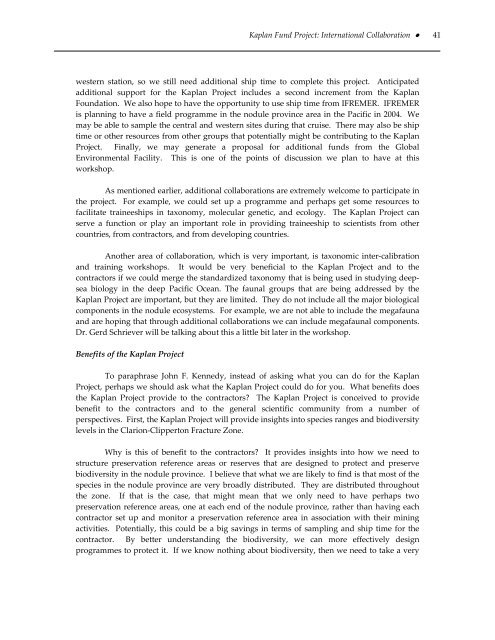PROSPECTS - International Seabed Authority
PROSPECTS - International Seabed Authority
PROSPECTS - International Seabed Authority
Create successful ePaper yourself
Turn your PDF publications into a flip-book with our unique Google optimized e-Paper software.
Kaplan Fund Project: <strong>International</strong> Collaboration ● 41<br />
western station, so we still need additional ship time to complete this project. Anticipated<br />
additional support for the Kaplan Project includes a second increment from the Kaplan<br />
Foundation. We also hope to have the opportunity to use ship time from IFREMER. IFREMER<br />
is planning to have a field programme in the nodule province area in the Pacific in 2004. We<br />
may be able to sample the central and western sites during that cruise. There may also be ship<br />
time or other resources from other groups that potentially might be contributing to the Kaplan<br />
Project. Finally, we may generate a proposal for additional funds from the Global<br />
Environmental Facility. This is one of the points of discussion we plan to have at this<br />
workshop.<br />
As mentioned earlier, additional collaborations are extremely welcome to participate in<br />
the project. For example, we could set up a programme and perhaps get some resources to<br />
facilitate traineeships in taxonomy, molecular genetic, and ecology. The Kaplan Project can<br />
serve a function or play an important role in providing traineeship to scientists from other<br />
countries, from contractors, and from developing countries.<br />
Another area of collaboration, which is very important, is taxonomic inter‐calibration<br />
and training workshops. It would be very beneficial to the Kaplan Project and to the<br />
contractors if we could merge the standardized taxonomy that is being used in studying deepsea<br />
biology in the deep Pacific Ocean. The faunal groups that are being addressed by the<br />
Kaplan Project are important, but they are limited. They do not include all the major biological<br />
components in the nodule ecosystems. For example, we are not able to include the megafauna<br />
and are hoping that through additional collaborations we can include megafaunal components.<br />
Dr. Gerd Schriever will be talking about this a little bit later in the workshop.<br />
Benefits of the Kaplan Project<br />
To paraphrase John F. Kennedy, instead of asking what you can do for the Kaplan<br />
Project, perhaps we should ask what the Kaplan Project could do for you. What benefits does<br />
the Kaplan Project provide to the contractors? The Kaplan Project is conceived to provide<br />
benefit to the contractors and to the general scientific community from a number of<br />
perspectives. First, the Kaplan Project will provide insights into species ranges and biodiversity<br />
levels in the Clarion‐Clipperton Fracture Zone.<br />
Why is this of benefit to the contractors? It provides insights into how we need to<br />
structure preservation reference areas or reserves that are designed to protect and preserve<br />
biodiversity in the nodule province. I believe that what we are likely to find is that most of the<br />
species in the nodule province are very broadly distributed. They are distributed throughout<br />
the zone. If that is the case, that might mean that we only need to have perhaps two<br />
preservation reference areas, one at each end of the nodule province, rather than having each<br />
contractor set up and monitor a preservation reference area in association with their mining<br />
activities. Potentially, this could be a big savings in terms of sampling and ship time for the<br />
contractor. By better understanding the biodiversity, we can more effectively design<br />
programmes to protect it. If we know nothing about biodiversity, then we need to take a very

















